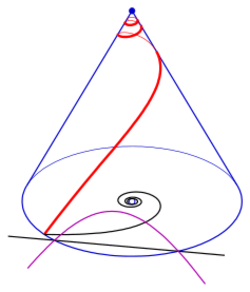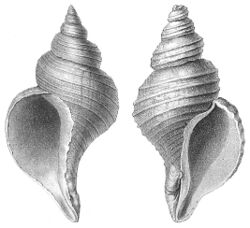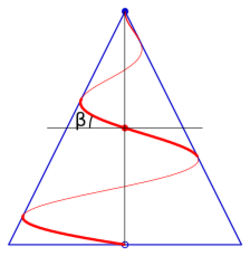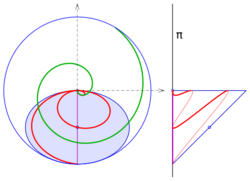Conical spiral




In mathematics, a conical spiral, also known as a conical helix,[1] is a space curve on a right circular cone, whose floor projection is a plane spiral. If the floor projection is a logarithmic spiral, it is called conchospiral (from conch).
Parametric representation
In the [math]\displaystyle{ x }[/math]-[math]\displaystyle{ y }[/math]-plane a spiral with parametric representation
- [math]\displaystyle{ x=r(\varphi)\cos\varphi \ ,\qquad y=r(\varphi)\sin\varphi }[/math]
a third coordinate [math]\displaystyle{ z(\varphi) }[/math] can be added such that the space curve lies on the cone with equation [math]\displaystyle{ \;m^2(x^2+y^2)=(z-z_0)^2\ ,\ m\gt 0\; }[/math] :
- [math]\displaystyle{ x=r(\varphi)\cos\varphi \ ,\qquad y=r(\varphi)\sin\varphi\ , \qquad \color{red}{z=z_0 + mr(\varphi)} \ . }[/math]
Such curves are called conical spirals.[2] They were known to Pappos.
Parameter [math]\displaystyle{ m }[/math] is the slope of the cone's lines with respect to the [math]\displaystyle{ x }[/math]-[math]\displaystyle{ y }[/math]-plane.
A conical spiral can instead be seen as the orthogonal projection of the floor plan spiral onto the cone.
Examples
- 1) Starting with an archimedean spiral [math]\displaystyle{ \;r(\varphi)=a\varphi\; }[/math] gives the conical spiral (see diagram)
- [math]\displaystyle{ x=a\varphi\cos\varphi \ ,\qquad y=a\varphi\sin\varphi\ , \qquad z=z_0 + ma\varphi \ ,\quad \varphi \ge 0 \ . }[/math]
- In this case the conical spiral can be seen as the intersection curve of the cone with a helicoid.
- 2) The second diagram shows a conical spiral with a Fermat's spiral [math]\displaystyle{ \;r(\varphi)=\pm a\sqrt{\varphi}\; }[/math] as floor plan.
- 3) The third example has a logarithmic spiral [math]\displaystyle{ \; r(\varphi)=a e^{k\varphi} \; }[/math] as floor plan. Its special feature is its constant slope (see below).
- Introducing the abbreviation [math]\displaystyle{ K=e^k }[/math]gives the description: [math]\displaystyle{ r(\varphi)=aK^\varphi }[/math].
- 4) Example 4 is based on a hyperbolic spiral [math]\displaystyle{ \; r(\varphi)=a/\varphi\; }[/math]. Such a spiral has an asymptote (black line), which is the floor plan of a hyperbola (purple). The conical spiral approaches the hyperbola for [math]\displaystyle{ \varphi \to 0 }[/math].
Properties
The following investigation deals with conical spirals of the form [math]\displaystyle{ r=a\varphi^n }[/math] and [math]\displaystyle{ r=ae^{k\varphi} }[/math], respectively.
Slope
The slope at a point of a conical spiral is the slope of this point's tangent with respect to the [math]\displaystyle{ x }[/math]-[math]\displaystyle{ y }[/math]-plane. The corresponding angle is its slope angle (see diagram):
- [math]\displaystyle{ \tan \beta = \frac{z'}{\sqrt{(x')^2+(y')^2}}=\frac{mr'}{\sqrt{(r')^2+r^2}}\ . }[/math]
A spiral with [math]\displaystyle{ r=a\varphi^n }[/math] gives:
- [math]\displaystyle{ \tan\beta=\frac{mn}{\sqrt{n^2+\varphi^2}}\ . }[/math]
For an archimedean spiral is [math]\displaystyle{ n=1 }[/math] and hence its slope is[math]\displaystyle{ \ \tan\beta=\tfrac{m}{\sqrt{1+\varphi^2}}\ . }[/math]
- For a logarithmic spiral with [math]\displaystyle{ r=ae^{k\varphi} }[/math] the slope is [math]\displaystyle{ \ \tan\beta= \tfrac{mk}{\sqrt{1+k^2}}\ }[/math] ([math]\displaystyle{ \color{red}{\text{ constant!}} }[/math] ).
Because of this property a conchospiral is called an equiangular conical spiral.
Arclength
The length of an arc of a conical spiral can be determined by
- [math]\displaystyle{ L=\int_{\varphi_1}^{\varphi_2}\sqrt{(x')^2+(y')^2+(z')^2}\,\mathrm{d}\varphi = \int_{\varphi_1}^{\varphi_2}\sqrt{(1+m^2)(r')^2+r^2}\,\mathrm{d}\varphi \ . }[/math]
For an archimedean spiral the integral can be solved with help of a table of integrals, analogously to the planar case:
- [math]\displaystyle{ L= \frac{a}{2} \left[\varphi\sqrt{(1+m^2) + \varphi^2} + (1+m^2)\ln \left(\varphi + \sqrt{(1+m^2) + \varphi^2}\right)\right ]_{\varphi_1}^{\varphi_2}\ . }[/math]
For a logarithmic spiral the integral can be solved easily:
- [math]\displaystyle{ L=\frac{\sqrt{(1+m^2)k^2+1}}{k}(r\big(\varphi_2)-r(\varphi_1)\big)\ . }[/math]
In other cases elliptical integrals occur.
Development
For the development of a conical spiral[3] the distance [math]\displaystyle{ \rho(\varphi) }[/math] of a curve point [math]\displaystyle{ (x,y,z) }[/math] to the cone's apex [math]\displaystyle{ (0,0,z_0) }[/math] and the relation between the angle [math]\displaystyle{ \varphi }[/math] and the corresponding angle [math]\displaystyle{ \psi }[/math] of the development have to be determined:
- [math]\displaystyle{ \rho=\sqrt{x^2+y^2+(z-z_0)^2}=\sqrt{1+m^2}\;r \ , }[/math]
- [math]\displaystyle{ \varphi= \sqrt{1+m^2}\psi \ . }[/math]
Hence the polar representation of the developed conical spiral is:
- [math]\displaystyle{ \rho(\psi)=\sqrt{1+m^2}\; r(\sqrt{1+m^2}\psi) }[/math]
In case of [math]\displaystyle{ r=a\varphi^n }[/math] the polar representation of the developed curve is
- [math]\displaystyle{ \rho=a\sqrt{1+m^2}^{\,n+1}\psi^n, }[/math]
which describes a spiral of the same type.
- If the floor plan of a conical spiral is an archimedean spiral than its development is an archimedean spiral.
- In case of a hyperbolic spiral ([math]\displaystyle{ n=-1 }[/math]) the development is congruent to the floor plan spiral.
In case of a logarithmic spiral [math]\displaystyle{ r=ae^{k\varphi} }[/math] the development is a logarithmic spiral:
- [math]\displaystyle{ \rho=a\sqrt{1+m^2}\;e^{k\sqrt{1+m^2}\psi}\ . }[/math]
Tangent trace
The collection of intersection points of the tangents of a conical spiral with the [math]\displaystyle{ x }[/math]-[math]\displaystyle{ y }[/math]-plane (plane through the cone's apex) is called its tangent trace.
For the conical spiral
- [math]\displaystyle{ (r\cos\varphi, r\sin\varphi,mr) }[/math]
the tangent vector is
- [math]\displaystyle{ (r'\cos\varphi-r\sin\varphi,r'\sin\varphi+r\cos\varphi,mr')^T }[/math]
and the tangent:
- [math]\displaystyle{ x(t)=r\cos\varphi+t(r'\cos\varphi-r\sin\varphi)\ , }[/math]
- [math]\displaystyle{ y(t)=r\sin\varphi +t(r'\sin\varphi+r\cos\varphi)\ , }[/math]
- [math]\displaystyle{ z(t)=mr+tmr'\ . }[/math]
The intersection point with the [math]\displaystyle{ x }[/math]-[math]\displaystyle{ y }[/math]-plane has parameter [math]\displaystyle{ t=-r/r' }[/math] and the intersection point is
- [math]\displaystyle{ \left( \frac{r^2}{r'}\sin\varphi, -\frac{r^2}{r'}\cos\varphi,0 \right)\ . }[/math]
[math]\displaystyle{ r=a\varphi^n }[/math] gives [math]\displaystyle{ \ \tfrac{r^2}{r'}=\tfrac{a}{n}\varphi^{n+1}\ }[/math] and the tangent trace is a spiral. In the case [math]\displaystyle{ n=-1 }[/math] (hyperbolic spiral) the tangent trace degenerates to a circle with radius [math]\displaystyle{ a }[/math] (see diagram). For [math]\displaystyle{ r=a e^{k\varphi} }[/math] one has [math]\displaystyle{ \ \tfrac{r^2}{r'}=\tfrac{r}{k}\ }[/math] and the tangent trace is a logarithmic spiral, which is congruent to the floor plan, because of the self-similarity of a logarithmic spiral.

References
- ↑ "Conical helix". https://mathcurve.com/courbes3d.gb/heliceconic/heliceconic.shtml.
- ↑ Siegmund Günther, Anton Edler von Braunmühl, Heinrich Wieleitner: Geschichte der mathematik. G. J. Göschen, 1921, p. 92.
- ↑ Theodor Schmid: Darstellende Geometrie. Band 2, Vereinigung wissenschaftlichen Verleger, 1921, p. 229.
External links
- Jamnitzer-Galerie: 3D-Spiralen. .
- Weisstein, Eric W.. "Conical Spiral". http://mathworld.wolfram.com/ConicalSpiral.html.
 |




